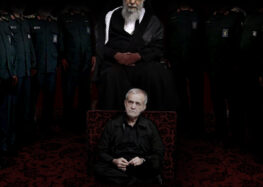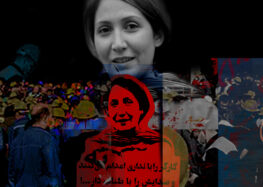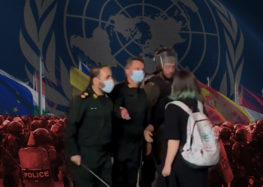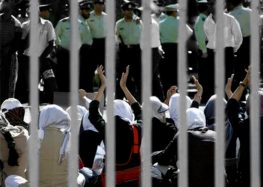Basij Commander Admits Forces Shot at 2009 Protesters

“A man at the top of that building was pointing a rifle at the people to threaten them and most people saw it; they can’t deny it,” Parvin Fahimi told Kaleme, regarding the shots fired at protesters in 2009.
After more than four years of denying that Basij and other security forces took direct shots at the 2009 post-election protesters, last week’s statements by the unnamed Commander of District 117-Neynava of IRGC’s Tehran Region, admitting for the first time that the men on top of a Basij base in Tehran shot at the protesters, has caused a stir among activists and the media. The unnamed Commander, however, has added that Basij forces only took shots after shots were fired by the crowd, and even then the Basij forces only targeted the protesters from the waist down. Photographs and video footage of the events on June 15, 2009, however, indicate otherwise.
In an interview with Kaleme Website following the Basij Commander’s statements, Parvin Fahimi, the mother of Sohrab Arabi, a protester who lost his life on June 15, refuted much of the Commander’s statements, but said again that she is willing to forgive those who killed her son in return for the release of the opposition leaders and all political prisoners.
Sohrab Aarabi, a 19-year old protestor, disappeared on June 15, 2009, during a post-election demonstration in Tehran. After a month’s search by his mother and promises by judicial authorities to release him on bail, his mother was contacted to identify his body in the morgue. Sohrab Arabi had been shot in the heart and in the arm. He was buried on July 13, 2009, at Behesht-e Zahra Cemetery in Tehran.
“I believe that it is a fortunate thing that after four years they are admitting some of the sins they committed and are confessing; that’s because people didn’t give in with all their pressure. Many families, like myself, did not withdraw our complaints, despite all the pressure placed on us during these four years. They pushed us to accept the diyah [the Sharia-based ‘blood money,’ which the government was willing to pay some of the victims’ families], but we didn’t accept it. They were pushing to end the cases with the diyah payments, but we insisted that they introduce the murderers and those who ordered the shootings, and our demand will stand to the end. I mean, until a fair and public trial is held, I will personally insist on my complaint,” said Parvin Fahimi. “I think right now they have come to the conclusion to confess their actions little by little. Well, at first they completely denied anyone had been killed; then they admitted a few had been killed; then they said [those murdered] were Basij forces; later they admitted they had beaten some people and made up different stories, and today they admit that they pointed guns at the people, and this is significant in itself,” Sohrab Arabi’s mother added.
Regarding the Basij commander’s claim about shooting at some protesters from waist down, Parvin Faimi said, “That’s not acceptable at all. All the kids who were killed and even the survivors who were injured and those whose spines were damaged were shot in their upper bodies…. Their words and conclusions contradict what organizations such as the Medical Examiner’s have said. All the shots recorded in the Medical Examiner’s reports from that day and later indicate that all the shootings took place from the top [of the building] aimed below [on the street], where the bullets entered the top parts of the bodies and left the lower bodies. This has been uniformly repeated in all reports, indicating the shots were fired from a distance of 7 to 15 meters. If there was a shooter among the crowd, from what distance and height could he have made the shot for this to happen?”
“According to the last report they gave me in 2011, Sohrab had received two bullets, one in his arm and the other in his chest, in the upper part of his rib cage, and this clearly shows that he was shot in the upper part of his body. It is the same way for the other kids, too, Kianoush, Ramin, etc.: they were all shot in the upper part of their bodies, and I believe the evidence for this exists and neither the Judiciary nor any other organization can deny it. I believe these statements are made to justify the mistakes they have made,” said Parvin Fahimi.
Asked about the claim that the protesters were trying to take over the Basij Base, Parvin Fahimi said, “How could empty-handed people attack? June 15, 2009, was the day of peaceful, silent protests. Most eyewitnesses saw three to four million people come out, all empty-handed, to protest. They had nothing with which to attack. They didn’t carry sticks and clubs, nor guns. Their silence was their protest. Another thing for which films and images are also available, is that a man at the top of that building was pointing a rifle at the people to threaten them and most people saw it; they can’t deny it. They should introduce that man to us. This is significant evidence that shows them attacking people from the [roof]top. They should introduce them so it is made clear who gave them guns and from where they received their orders,” said Parvin Fahimi.






